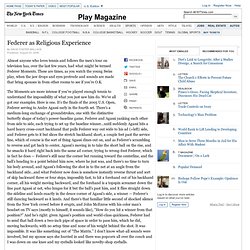

Roger Federer as Religious Experience - Tennis. The Moments are more intense if you’ve played enough tennis to understand the impossibility of what you just saw him do.

We’ve all got our examples. Here is one. It’s the finals of the 2005 U.S. Open, Federer serving to Andre Agassi early in the fourth set. Anyway, that’s one example of a Federer Moment, and that was merely on TV — and the truth is that TV tennis is to live tennis pretty much as video porn is to the felt reality of human love. Journalistically speaking, there is no hot news to offer you about Roger Federer. This present article is more about a spectator’s experience of Federer, and its context. Beauty is not the goal of competitive sports, but high-level sports are a prime venue for the expression of human beauty. The human beauty we’re talking about here is beauty of a particular type; it might be called kinetic beauty. Of course, in men’s sports no one ever talks about beauty or grace or the body. The perfect dancer rules, though momentarily. Updated: Thu, Jun 30 2011. 08 55 PM IST I always wondered if Roger Federer collects art, visits museums, shrugs on a tuxedo and wanders off to the ballet to see racket-less versions of himself.

Dancers, in their exquisite athleticism on a stage, in their suppression of pain during performance, are clearly athletes. The reverse occurs less frequently when an athlete produces such a harmonious yet lethal rhythm we liken it to dance. Dutch TV was so taken with footballer Marco van Basten that they did a split-screen comparison between him and a ballet dancer. In our imaginations, we have done the same when Michael Holding ran in, Michael Jordan climbed air, Cubans boxed. From 2004-07, when he won 11 of his majors, his winning was rivalled by the method of his winning, his whispering feet, the symmetry of his stroke, or what we might call his elegant reinterpretation of tennis. Out of tune: This was the first Grand Slam match Federer lost after leading 2-0. Murray rounds off tennis’ annus mirabilis. Four hours and fifty four minutes.

That’s the time it takes some athletes to run two marathons. And it’s the time it took Andy Murray to battle Novak Djokovic, blustery winds, physical pain, mental pressure, a nation’s expectations and the weight of history before he reached the finish line – a hobbling, understated kiss of the tape with head unbowed and spirit undefeated. For four hours and fifty four minutes tennis could have been boxing, with Murray and Djokovic dealing punch after counter-punch, each showing signs of pain, anger and frustration. There was a visceral quality to some of Djokovic’s forehands but there stood Murray, confident in his defense, absorbing blows and returning powerfully. It’s no wonder that Andre Agassi compares the two sports: “Only boxers can understand the loneliness of tennis players,” he writes in his book Open, “and yet boxers have their corner men and managers … Of all the games men and women play, tennis is the closest to solitary confinement.”
How did Rafael Nadal humble the great Roger Federer and - 05.18.09. The number that best summed up Roger Federer in his prime?

There are plenty to choose from: the record 237 consecutive weeks at No. 1, the 13 major titles, the 10 straight Grand Slam finals and 19 straight semifinals. But let's try this number: zero. Because the most astonishing thing about Federer's four-year run atop pro tennis, from February 2004 to August 2008, may be the difference between his exalted estimation of his own skills and what he actually did. There was none. For those inclined to deflate the self-adoring, though, Federer didn't present an easy target. And even if some were irked by such statements, could they really dispute them? The most beautiful game. Geoff Dyer considers the beauty of tennis Some people can’t bear football.

But is there anyone who doesn’t—to put it mildly—like tennis? Whereas football games are routinely tedious, tennis matches only occasionally disappoint (as when an unknown player carves a heroic path through a Grand Slam only to capitulate helplessly in the final). The standard of an averagely important tennis match—the kind you might see on an outside court in an early round at Queen’s—is superhuman. This is striking because it is such a difficult game to play. The first thing you have to do is serve—and it’s extremely difficult to serve, to get the ball over the net and into the service box. Don’t worry, this is not going to turn into a coaching manual (as if!). But here’s the thing, here’s the lovely covenant of tennis: despite the huge gulf between them and us, everything that happens to the top players during a Grand Slam match is replicated by an average player in a park.